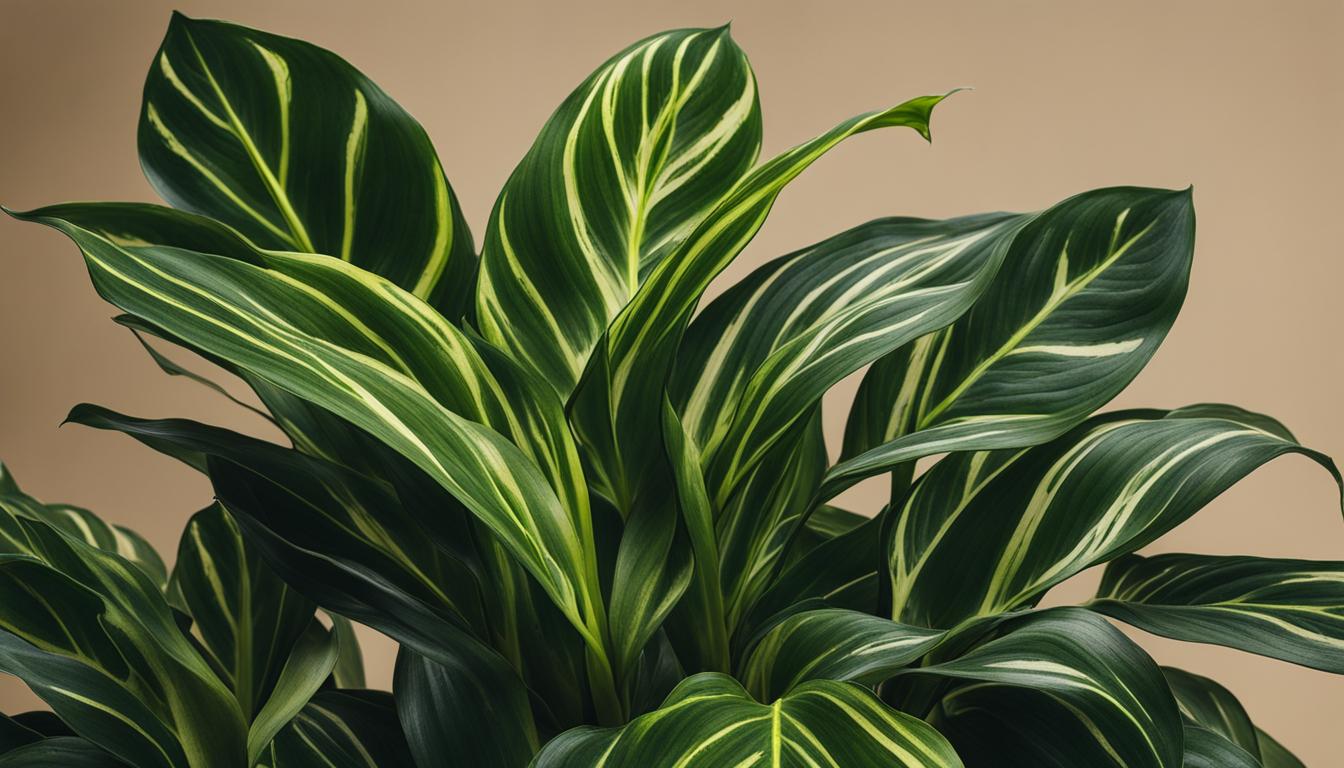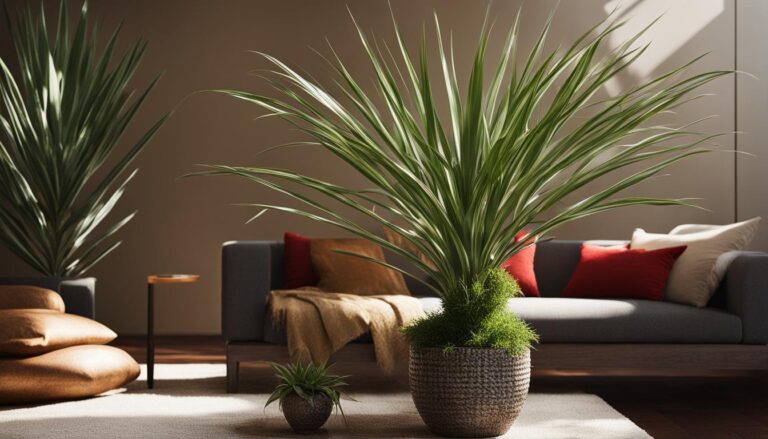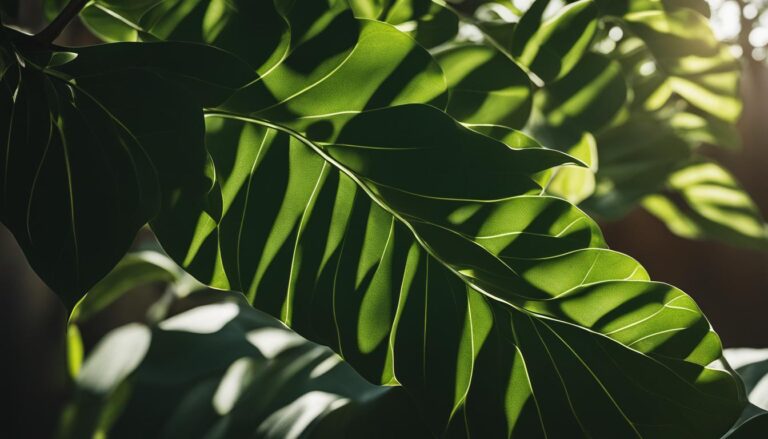
Welcome to a quick guide on mastering the growth of Aglaonema, also known as Chinese Evergreen. As a popular houseplant, Aglaonema is beloved for its striking appearance and low-maintenance requirements.
In this article, I will provide you with essential care tips, propagation methods, and information on common leaf problems and diseases. So, let’s dive into the world of Aglaonema and discover how to keep these indoor plants thriving.
Aglaonema is available in a variety of stunning leaf patterns and colors. Each Aglaonema variety brings a unique touch to your indoor space. From vibrant red patterns to green mottled leaves, there’s a perfect Aglaonema for every plant enthusiast.
In the next section, I will guide you through the different Aglaonema varieties, highlighting their distinctive features and appearances.
Growing and maintaining healthy Chinese Evergreens requires specific care tips. From soil requirements to lighting conditions, I will provide you with the essential knowledge on how to ensure optimal growth for your Aglaonemas.
Whether you’re a beginner or an experienced gardener, these care tips will help you keep your Chinese Evergreens thriving for years to come. So, let’s explore the key aspects of Aglaonema plant care in detail.
Aglaonema Varieties: A Guide to Different Leaf Patterns and Colors
Aglaonema varieties offer a wide range of stunning leaf patterns and colors, making them a popular choice among indoor plant enthusiasts. Each variety has its own unique characteristics that add beauty and vibrancy to any space.
Aglaonema Modestum
A. modestum, also known as the true Chinese Evergreen, may have a dull appearance compared to other varieties. However, it still holds its own charm with its lush green foliage. It is a great option for those who prefer a more subtle and simple aesthetic.
Aglaonema Crispum ‘Silver Queen’
For those looking for a variety with a touch of elegance, A. crispum ‘Silver Queen’ is an excellent choice. Its green leaves are beautifully adorned with blotched silver patterns, creating a striking contrast. This variety adds a touch of sophistication to any indoor space.
Aglaonema Treubii
A. treubii is a captivating variety with green mottled and cream leaves. The intricate patterns on its foliage create a visually captivating display that is sure to catch the eye. This variety adds a touch of uniqueness and charm to any room.
Aglaonema Commutatum ‘Pseudobracteatum’ (Golden Evergreen)
Another stunning variety is A. commutatum ‘Pseudobracteatum,’ also known as ‘Golden Evergreen.’ It features spear-shaped leaves with a deep green color and creamy gold marks. This variety adds a touch of warmth and elegance to any indoor environment.
Explore the diverse range of Aglaonema varieties and choose the one that best suits your style and preferences. Whether you prefer a subtle and simple look or a bold and vibrant display, there is an Aglaonema variety that will fit perfectly into your space.
| Variety | Leaf Patterns | Colors |
|---|---|---|
| Aglaonema Modestum | Dull appearance | Lush green |
| Aglaonema Crispum ‘Silver Queen’ | Blotched silver | Green |
| Aglaonema Treubii | Green mottled and cream | – |
| Aglaonema Commutatum ‘Pseudobracteatum’ (Golden Evergreen) | Deep green with creamy gold marks | – |
Aglaonema Care Tips: How to Grow and Maintain Healthy Chinese Evergreens
As an experienced gardener, I’ve learned some valuable Aglaonema care tips that can help you grow and maintain healthy Chinese Evergreens. These beautiful plants are known for their low-maintenance requirements and striking appearance, making them a popular choice for indoor gardening.
First and foremost, it’s essential to provide Aglaonemas with well-draining soil to prevent waterlogging and root rot. You should repot your Chinese Evergreens every three to four years to ensure they have enough space for healthy growth.
When it comes to lighting, Aglaonemas thrive in bright, indirect light. They love lots of natural light, but direct sunlight can scorch their leaves. To maintain their vibrant foliage, make sure to keep your Aglaonemas in a spot with plenty of bright, indirect light.
| Care Aspect | Details |
|---|---|
| Light | Prefers indirect, medium to low light. Avoid direct sunlight, which can scorch the leaves. |
| Watering | Water when the top inch of soil is dry. Do not overwater. |
| Humidity | Enjoys high humidity but can tolerate average indoor humidity. |
| Temperature | Prefers temperatures between 65°F and 80°F (18°C – 27°C). Avoid drafts and sudden changes. |
| Soil | Well-draining potting mix. |
| Fertilization | Feed with a balanced, water-soluble fertilizer every month during the growing season. |
| Repotting | Repot every 2-3 years or when roots outgrow the pot. |
| Toxicity | Toxic to pets and humans if ingested. Keep out of reach of children and animals. |
| Air Purification | Known to filter indoor air pollutants. |
Proper watering is crucial for the health of your Aglaonemas. While they like to be kept moist, overwatering can cause root rot. Water them when the top inch of soil feels slightly dry, and make sure the pot has drainage holes to allow excess water to escape.
Fertilizing your Aglaonemas regularly is also important for their growth and development. Use a balanced, water-soluble fertilizer and follow the recommended dosage. I suggest fertilizing them every four to six weeks during the growing season.
By following these Aglaonema care tips, you can enjoy the beauty of Chinese Evergreens in your home or office. Remember to provide them with well-draining soil, bright indirect light, proper watering, and regular fertilization to keep them healthy and thriving.
FAQ
What is Aglaonema?
Aglaonema, also known as Chinese Evergreen, is a popular houseplant cherished for its low-maintenance requirements and stunning appearance.
How can Aglaonemas be propagated?
Aglaonemas can be propagated through stem cuttings and division.
What are the common problems with Aglaonemas?
Common problems with Aglaonemas include cold temperatures, leaf spot, botrytis, root mealy bugs, and mealy bugs.
What are the ideal growing conditions for Aglaonemas?
Aglaonemas require well-draining soil, moderate humidity, and indirect sunlight for healthy growth. The ideal temperature is between 70-75°F.
How often should Aglaonemas be watered?
Aglaonemas require regular watering to keep the soil moist, but overwatering should be avoided.
Why is fertilizing important for Aglaonemas?
Fertilizing Aglaonemas is crucial for their growth and development.
What is a Red Aglaonema?
Red Aglaonemas are a stunning variety with vibrant red patterned foliage.
What are the light requirements for Red Aglaonemas?
Red Aglaonemas require high to medium light conditions for optimal growth.
How can Red Aglaonemas be propagated?
Red Aglaonemas can be propagated through stem cuttings and division.
What are the common pests and diseases that affect Red Aglaonemas?
Common pests and diseases that can affect Red Aglaonemas include spider mites, mealybugs, leaf spot disease, and root rot.
What are the different Aglaonema varieties available?
Aglaonema varieties offer a wide range of leaf patterns and colors. Some popular varieties include A. modestum, A. crispum ‘Silver Queen,’ A. treubii, and A. commutatum ‘Pseudobracteatum.’
How often should Aglaonemas be repotted?
Aglaonemas should be repotted every three to four years.
How can Aglaonemas be protected from cold temperatures?
Aglaonemas should be protected from cold temperatures to prevent damage to the leaves.
What are some common leaf problems with Aglaonemas?
Common Aglaonema leaf problems include brown leaf edges and dry tips, which indicate poor growing conditions.
Why do Aglaonema leaves turn yellow and wilt?
Yellowing and wilting of Aglaonema leaves can be caused by overwatering or poor drainage.
Why do Aglaonemas look pale and patchy?
Pale and patchy-looking Aglaonemas may be receiving too much direct sunlight.
Why do Aglaonemas lose variegation?
Aglaonemas can lose variegation if they are not receiving enough indirect light.






